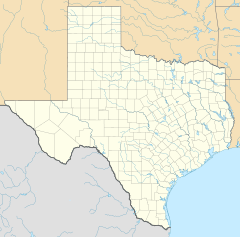Cayuga, Texas facts for kids
Quick facts for kids
Cayuga, Texas
|
|
|---|---|
| Country | United States |
| State | Texas |
| County | Anderson |
| Elevation | 308 ft (94 m) |
| Time zone | UTC-6 (Central (CST)) |
| • Summer (DST) | UTC-5 (CDT) |
| ZIP codes |
75832
|
| Area code(s) | 430 & 903 |
| GNIS feature ID | 1379518 |
Cayuga is a small community in Anderson County, Texas, United States. It is not officially a city, but it is a place where people live and work. In 2000, about 200 people lived there. Cayuga is part of the wider area around the city of Palestine, Texas.
Contents
A Look Back: Cayuga's History
Cayuga got its name in 1894. The first postmaster, William Alonzo Davenport, named it after his hometown, Cayuga, New York. The community started growing in the 1880s. People from older nearby places like Gilmore's Chapel, Wild Cat Bluff, and Bethel moved there. These older places were settled in the 1840s and 1850s.
Early Churches and Community Life
In 1854, the Judson Baptist Church began. It started in a simple outdoor shelter near Charles Gilmore's home. Settlers also created the first Methodist Church in this part of Anderson County. Later, the Judson Baptist Church moved to the location of the Judson Cemetery. This cemetery was first called Gilmore's Chapel Cemetery. It is now abandoned and sometimes called Old Judson Cemetery.
In 1911, Judson Church moved again to land given by H. S. Clay. It later moved to its current spot. Other churches also served Cayuga. The Joppa Holiness Church was active from 1899 to 1907. The Freeman Baptist Church held services from 1910 to 1934.
The Oil Boom and Changes Over Time
Cayuga was a small farming community for many years. But in 1934, everything changed. The Tidewater Oil Company found oil nearby. This discovery, called the J.N. Edens No. 1, turned Cayuga into an oil boomtown almost overnight. By 1936, over 1,000 people lived there, and there were 15 businesses.
After World War II, the oil boom slowed down. The community's population dropped to 200 by 1952. It fell even more to just 56 residents by 1974. At that time, only two businesses were left.
However, Cayuga saw a new beginning. The Richland-Chambers Creek Reservoir was found in nearby counties. Also, four state prisons were built in the area. Soon after, large amounts of lignite (a type of coal) were discovered. By 1988, about 700 people lived in Cayuga. There were also several businesses, including offices for two big petroleum companies. The population dropped to 56 in 1990 but grew back to 200 by 2000.
Cayuga has its own post office. Its ZIP code is 75832.
Where is Cayuga? (Geography)
Cayuga is located where U.S. Highway 287 and Farm to Market Road 59 meet. It is about 5 kilometers (3 miles) east of the Trinity River. This area is in the northwestern part of Anderson County.
Nearby Cities
- Palestine is about 27 kilometers (17 miles) southwest.
- Corsicana is about 32 kilometers (20 miles) west.
- Athens is about 20 kilometers (12 miles) north.
Learning in Cayuga (Education)
The first school in the Cayuga area started at Charles Gilmore's home. George W. Tuggle taught there. He was also a chief justice (a type of judge) for Anderson County. In 1860, he and his wife, Elizabeth Tuggle, gave land for the first schoolhouse.
This school stayed in that spot until the 1880s. Then it moved to the Cayuga-Blackfoot road. In 1922, it moved again to an unknown spot near Farm to Market Road 59. In 1974, the school was moved to Bethel, Texas. Today, students in the community attend schools in the Cayuga Independent School District.
Famous Faces from Cayuga
- Shelby Metcalf: He was a basketball coach. He spent one year as the head basketball coach at Cayuga High School.



